[/caption]
Here’s an event we don’t get to see very often. It is a post-launch activity that is not well publicized and of course, with the retirement of the space shuttles fast approaching, we have just a few opportunities to see it again. Early Monday morning, the solid rocket boosters used for space shuttle Atlantis’ launch last week were towed back to Port Canaveral after their recovery from the Atlantic Ocean. Universe Today photographer Alan Walters captured some images of the return, and in the image above, the Liberty Star — one of two unique ships specifically designed and constructed for this task — returns one booster through the locks at the Port. Visible is the “business end” of the booster. A spokesperson at Kennedy Space Center said these two boosters will be refurbished, just in case they are needed in the future.
See more images below.
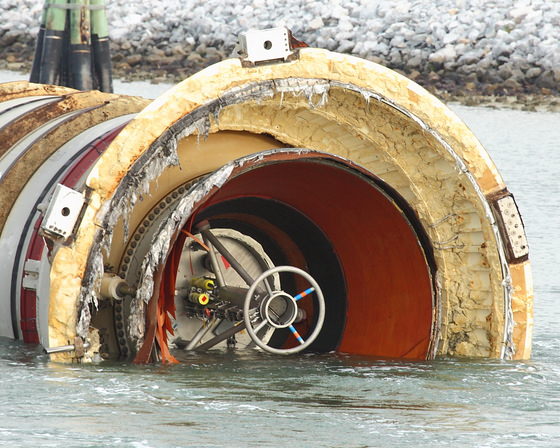
Here’s a close-up of the nozzle end of the SRB, a little worse for wear after the launch. After the boosters do their job and are jettisoned from the shuttle, they fall back to the ocean. The parachutes provide for a nozzle-first impact, so air is trapped in the empty motor casing, causing the booster to float with the forward end approximately 30 feet (9.1 m) out of the water. Once the boosters are located, divers insert a plug in the nozzle (the metal object in the middle of the nozzle) called the Diver Operated Plug. The divers “dewater” the SRBs by pumping air into and water out of the SRB. This causes the SRB to change from a nose-up floating position to a horizontal attitude more suitable for towing.
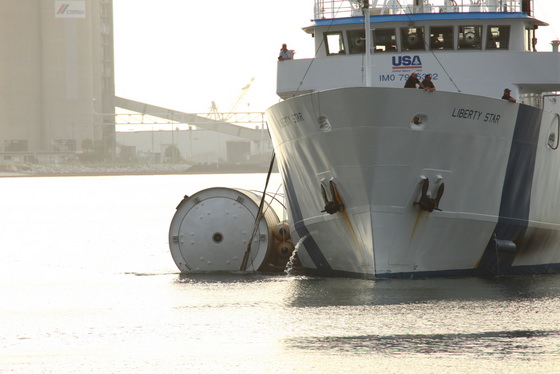
The top end of the SRB is visible in this image. The nose cap is jettisoned at an altitude of 2.9 statute miles (2.5 nautical miles/4.6 kilometers) and deploys the pilot parachute.
An SRB fully loaded with propellant weighs about 1.4 million pounds (635,040 kilograms). They stand 149.2 feet (45.5 meters) tall, and have a diameter of 12 feet (3.6 meters). The boosters in use today are the largest solid propellant motors ever developed for space flight and the first to be used on a manned space vehicle. These boosters will propel the orbiter to a speed of 3,512 miles per hour (5,652 kilometers per hour).
Approximately two minutes after the Space Shuttle lifts off from the launch pad, the twin SRBs have expended their fuel, and the boosters separate from the orbiter and its external tank at an altitude of approximately 30.3 statute miles (26.3 nautical miles/48.7 kilometers) above the Earth. After separation, momentum will propel the SRBs for another 70 seconds to an altitude of 44.5 statute miles (38.6 nautical miles/71.6 kilometers) before they begin their long tumble back to Earth.
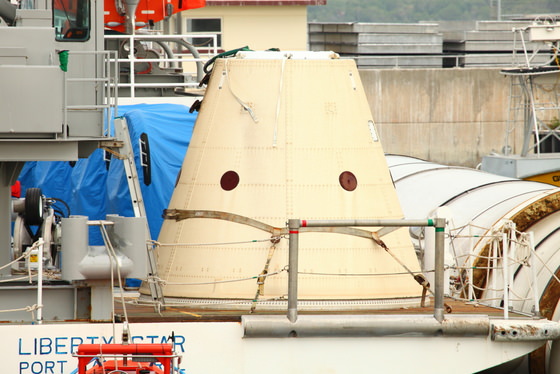
This is the frustum, which holds the drogue shoot. It is jettisoned from the booster after the drogue shoot stabilizes the SRB in a tail-first attitude, and is separated by a pyrotechnic charge about 243 seconds after SRB separation.
The main parachutes are the first items to be brought on board the recovery ships. Their shroud lines are wound onto each of three of the four reels on the ship’s deck. The drogue parachute, attached to the frustum, is reeled onto the fourth reel until the frustum is approximately 50 feet astern of the ship. The 5,000-pound (2,268-kilogram) frustum is then lifted from the water using the ship’s power block and deck crane.
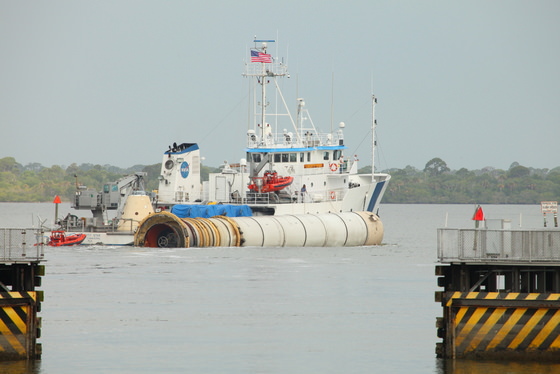
The ships enter Port Canaveral, where the booster is changed from the stern tow position to a position alongside the ship to allow greater control. The ships then pass through a drawbridge, Canaveral Locks, and transit the Banana River to a hanger. They are lifted from the water with specially made Straddle-Lift cranes and placed on rail cars to begin the disassembly and refurbishment process.
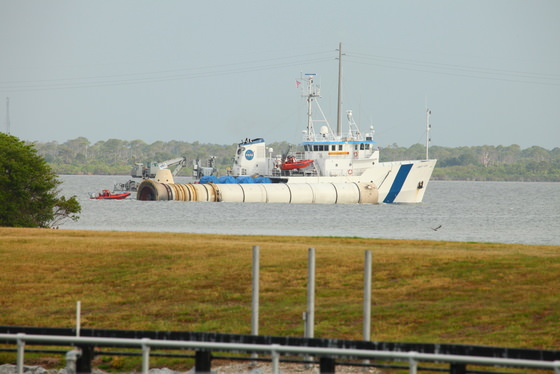
The Liberty Star and the Freedom star each have a crew of ten; a nine-person SRB retrieval team, a retrieval supervisor, a NASA representative, and some observers, with the maximum complement at 24 persons.
While the ships were built especially for NASA for retrieving the SRBs, they’ve also been used for other purposes, including side-scan sonar operations, cable-laying, underwater search and salvage, drone aircraft recovery, platforms for robotic submarine operations and numerous support roles for other government agencies.
The ships have a special water jet system in the stern thruster which allows the ship to move in any direction without the use of propellers. This system was installed to protect the endangered manatee population that inhabits regions of the Banana River where the ships are based. The system also allows divers to work near the ship during operations at a greatly reduced risk.
Thanks to Alan Walters for getting up early this morning to capture these great, unique images.

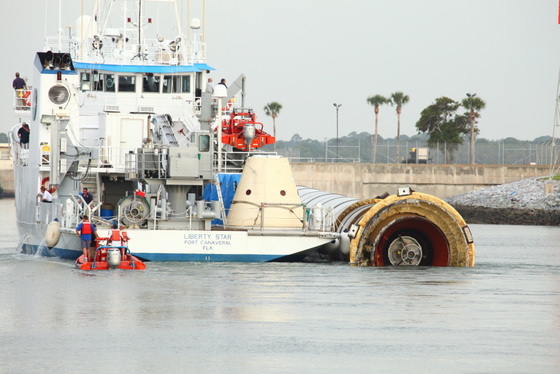
If there are two of them, aren’t they “bisique” rather than “unique”?
@ Sili,
According to Dictionary.com, the earliest meanings of the term “unique”, when it entered English around the beginning of the 17th century, were “single” or “sole” and “having no equal”; however, by the mid-19th century, “unique” had developed a wider meaning of “not typical” or “unusual”, and it is in this wider sense that it is compared. The comparison of so-called absolutes in senses that are not absolute is standard in all varieties of speech and writing.
So, it’s all about semantics. 🙂
“The [solid rocket]boosters in use today are…..the first to be used on a manned space vehicle.”
Alan Shepard rode a Redstone 3 on a suborbital flight May 5, 1961, to become the first American in space: http://en.wikipedia.org/wiki/Freedom_7
The SRBs are also outfitted with 3 cameras apiece(fore, aft and centerstage) that capture some truly astonishing views of the shuttle and the ET on the path to orbit. Flight engineers also scrutinize this footage to check for possible ‘impact events’ on the underside of the orbiter. Usually these are broadcast on NASA TV a few days after the SRBs are recovered (though the airing dates are not currently listed on the STS-132 schedule).
“”According to Dictionary.com, the earliest meanings of the term “unique”, when it entered English around the beginning of the 17th century, were “single” or “sole” and “having no equal”; however, by the mid-19th century, “unique” had developed a wider meaning of “not typical” or “unusual”, and it is in this wider sense that it is compared. The comparison of so-called absolutes in senses that are not absolute is standard in all varieties of speech and writing.””
O……M…….G !!!! I have four guys standing here reading these insane comments with cold beers in their hands and needless to say I won’t repeat their commentary.
@ mgjohnson,
I think that you and your beer drinking associates have not been reading the comments section on Universe Today for long enough to fully appreciate as to what constitutes “insane comments” and to what extent such comments can often descend to on these pages. If you guys had done so and had noted the pseudo-science irrationality from the “Electric Universe” proponents, who have, in the past, often plagued the comments section whenever the subject of “magnetic fields” in space is mentioned in an article on Universe Today, then you guys might have come to a different conclusion about the above comments, which are very mild in comparison.
So, to give you some real examples of “insane comments”, I will refer you and your beer drinking buddies to these pages on Universe Today featuring the comments by “Electric Universe” proponents “Anaconda”, “solrey”, and “OilIsMastery” (that last guy really takes the biscuit!): CLICK HERE.
N.B. After reading some of those comments, you and your buddies are going to need something stronger than beer! 😉
This is a great story for it’s timely insight and rare images which are genuinely appreciated. But with greatest respect and gratitude to the journalist who wrote it, Mr Walters and the dedicated 48 strong compliment of the Liberty Star and Freedom Star, NASA’s navy should go to the auction block this year.
Reasoning:
(1) There are no more Space Shuttle external fuel tank barges to be towed,
(2) there are no future Ares I or Ares V SRBs to be retrieved,
(3) at an average of less than five Shuttle flights per year, retrieving spent Space Shuttle SRBs could have been contracted out to the CG, USN or a private operator on a casual needs basis who may have opted for one existing boat to retrieve both SRBs rather than NASA owning and operating two custom boats to retrieve a single SRB each.
It’s difficult to count the number of times NASA have disappointed and cancelled promising projects due to “budget constraints”, so space enthusiasts support as much funding as required, just not in the blank cheque fashion of No Accounting Sense Anywhere.